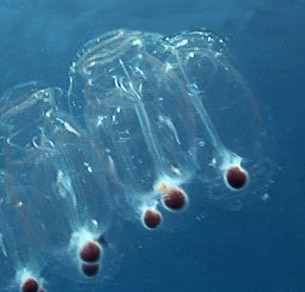Salp
Category: Jellyfish

Facts about Sea Salps, Two Salps are common in Antarctic waters scientificly known as: Ihlea racovitzai and Salpa thompsoni. Salps (Sea Walnuts) are ctenophores. This means they look like jelly fishes with no sting. They are found mostly to the eastern coast of North and South America. Sea Salps was identified for the first time in 1982 in the Black Sea. Researchers guessed they had been transported to the Black Sea by ballast water. Few years later Salps were rediscovered in the Caspian Sea. One unique thing about the Sea Walnuts is that they are extremely colonial. They multiply rapidly and form highly dense populations called “swarmsâ€. No other animal is ever seen to be as numerous as Salps are.
Food for Sea Salps
Salps feed in zooplanktons i.e. small aquatic animals which are food to commercial fishes. An immense population of Sea Walnuts had once become the reason for collapsing of local fishery once. The Salps have been discovered in Mediterranean Sea and Baltic Sea afterwards.
Habit and Habitat of Sea Salps
Salps (Sea Walnuts) are invertebrates (don’t have a spinal cord). They are marine planktonics (live in oceans, coastal waster for their whole life span) and look like sea gooseberry morphologically. Their body is divided into eight lobes. Adult Salps don’t have the conspicuous tentacles while the younger ones have. A fully grown Salp can be of 15 cm long.
The Salp have a comb like organ on both sides of their body that emits a bluish white luminescence. When they form dense swarms in night, these small lights combine to make the sea glow. The sea looks more like scenery from a distance. Pattern shows that they are abundantly found in warm areas, but they also have been discovered in higher latitudes.
The Salps are harmless to humans. The Salp have received their common name also walnut from the eastern coast of America. The Salp make the news at times for invading local fishery water locks and putting the zooplankton meant for the fishes to an end which severely affects the business. It takes time to get rid of them as if one of them is left in a water lock, it can multiply itself to give birth to hundreds.

 Back To Category Jellyfish
Back To Category Jellyfish